
JOURNAL SUMMARY
Effect of feeding complete feed block containing rumen Protected protein, non-protein nitrogen and rumen protected fat on improving body condition and carcass traits of cull ewes
Journal of Animal Physiology and Animal Nutrition
Background
Sheep are among the livestock raised for meat production. In many developing countries (including India), about 40% of sheep are slaughtered in conditions categorized as culling. Farmers in developing countries, including India, often overlook Body Condition Score (BCS) of sheep, resulting in low-quality animals with limited meat production. Improvement efforts could involve feeding concentrates for 90 days to enhance carcass composition and meat quality, making it suitable for consumers. However, high costs and increased fat content pose challenges.
To address this, previous studies focused on reducing feeding periods or adding non-protein nitrogen (NPN) and rumen-protected fat. These approaches involved excessive concentrate intake, leading to excessive fat accumulation and poor feed conversion. Therefore, these methods are considered inefficient. Excessive concentrate feeding can also increase the occurrence of bloat, acidosis, and laminitis. An alternative solution to concentrates is a complete feed block containing high-fiber forage and a balanced concentrate suitable for the sheep's digestive system.
Objective
This study aims to determine the impact of feeding complete feed blocks on improving BCS, carcass traits, and carcass yield of cull ewes before slaughter.
Materials and Methods
Materials
The study was conducted at the Central Sheep and Wool Research Institute, India. A total of 41 cull ewes with an average age above 6 years and a weight of 31.4 kg were used. Five ewes were slaughtered on day 0 to assess carcass characteristics. The remaining 36 ewes were randomly assigned to three groups of 12 each and housed individually and intensively. The ewes were allowed to graze from 6:00 to 8:00 and 17:00 to 19:00.
Feed Treatment and Live Weight Recording
The feed was given ad libitum in the form of Complete Feed Blocks (CFB) with a composition of 65% concentrate, 30% straw, and 5% molasses. The CFB was created by first mixing urea and molasses, then evenly spraying them onto the concentrate and straw. The mixture was then uniformly mixed using a horizontal mixer. The mixture was pressed at 5000 psi (351.5 kg/cm2) using a CFB pressing machine.
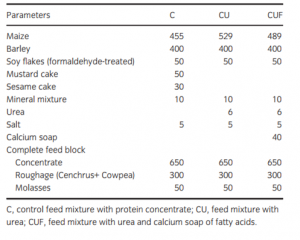
Table 1. Composition of CFB in 3 different treatments
The treatments were divided into three groups: the first treatment was a control with rumen-protected protein (1% formaldehyde-treated soy flake), the second treatment was the control plus urea, and the third treatment was the control plus urea and rumen-protected fat (RPF). RPF is a calcium soap prepared from rice bran oil. The creation of calcium soap involved the addition of anhydrous calcium hydroxide (40% of the amount of rice bran oil) dissolved in water 15 times the amount of calcium hydroxide, followed by the addition of sulfuric acid (3% of the amount of rice bran oil). The mixture was stirred for 25 minutes over low heat, then filtered, washed, and dried. The finished calcium soap contained 63% oil and 37% mineral. The treatments in this study are shown in table 1. The treatments were administered for 90 days. Weighing was done weekly before feeding. BCS was measured on day 0 and day 90.
Sampling and Analysis
Rumen fluid was collected on day 0 and 90 using a stomach tube connected to a suction pump. Rumen fluid was analyzed for total nitrogen (TN), trichloroacetic acid (TCA) soluble N (Micro Kjeldahl), ammonia nitrogen (NH3-N; Weatherburn, 1967), and volatile fatty acids (VFA) using gas chromatography. Feces and feed samples were also collected on day 0 and 90. Purine derivatives were analyzed using the IAEA enzymatic method, and microbial nitrogen was analyzed using the method of Chen and Gomse (1992).
All ewes were slaughtered on day 90. Weights were measured after slaughter, and carcasses were weighed. Moisture content, CP, ether extract, and ash content in feed and feces were determined using the AOAC method, and NDF and ADF were analyzed using Van Soest. Statistical analysis was conducted using a mixed model with SAS software.
Table 2. Nutritional composition of CFB
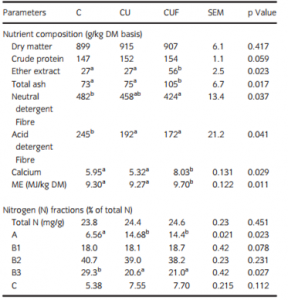
Results and Discussion
Nutritional composition differed significantly between treatments, particularly in some nutrient components such as crude fat, total ash, NDF, ADF, and calcium. These differences resulted from the addition of feed materials in the CU and CUF treatments. The addition of urea increased the nitrogen content in the feed, thus raising the NDF value. Additionally, the CUF treatment included calcium and oil, resulting in higher fat content in the feed. The feed composition can be seen in table 2.
There was no significant difference in dry matter digestibility (table 3). However, there were differences in organic matter digestibility, crude protein, and crude fat digestibility. Crude protein digestibility increased in the CU and CUF treatments due to added nitrogen from urea. The CUF treatment had increased crude fat digestibility compared to the other treatments, indicating that rumen-protected fat functioned well in improving crude fat digestibility. Meanwhile, N intake, N in feces, and N retention increased in the CU and CUF treatments due to the addition of urea in the feed.
Daily feed intake did not significantly differ between the control and CUF treatment groups, but it did differ significantly from the CU group (table 3). The difference in feed intake in the CUF treatment might be due to the low palatability caused by the addition of calcium soap, resulting in decreased palatability. Protein intake, however, increased in the CU and CUF treatments due to the added nitrogen from urea.
Table 3. Digestibility and N content in feces and urine
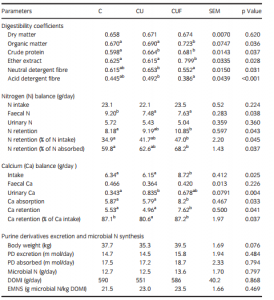
Initial body weight (table 4) showed no significant difference, indicating that the initial body weights were similar, and therefore the final results cannot be attributed to differences in initial body weight. The final weight before slaughter in the CUF treatment was higher than in the other treatments. This is attributed to the addition of calcium soap, which binds fat and increases fat bypass, making it digestible. This is consistent with the higher crude fat digestibility in the CUF treatment compared to other treatments (table 3). The highest total weight gain was in the CUF treatment, with an increase of 10 kg over 90 days. Similarly, the daily weight gain was the highest in the CUF treatment, with a gain of 111 g per day. These values were the highest among all treatments.
Table 4. Feed intake and body weight gain
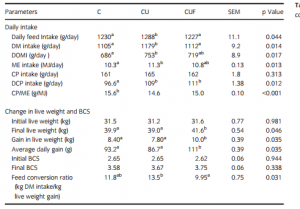
High lean yield and fat deposition are due to high crude protein and crude fat content in the longissimus dorsi muscle, as well as high adipose tissue content compared to sheep on days 7 and 11 (table 6). Previous research has shown that higher energy and protein consumption before slaughter reduces longissimus dorsi muscle.
Table 6. Carcass quality after slaughter
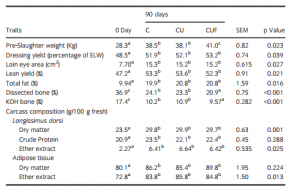
Conclusion
Replacing conventional high-protein concentrates with cheaper alternatives such as urea as a nitrogen source, while considering protein and energy requirements and efficient utilization of these nutrients through protection from rumen degradation for both fat and protein, has proven successful. The strategy of providing complete free blocks (CFB) results in compensatory body weight gain, leading to increased slaughter weight and reduced bone percentage.



